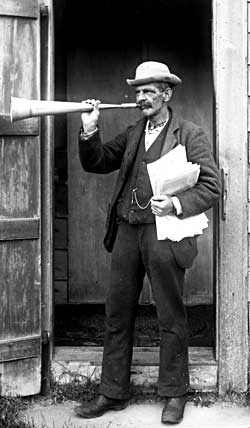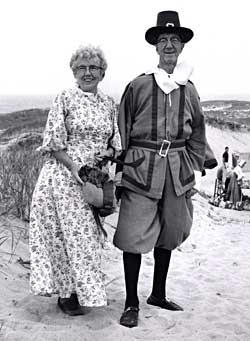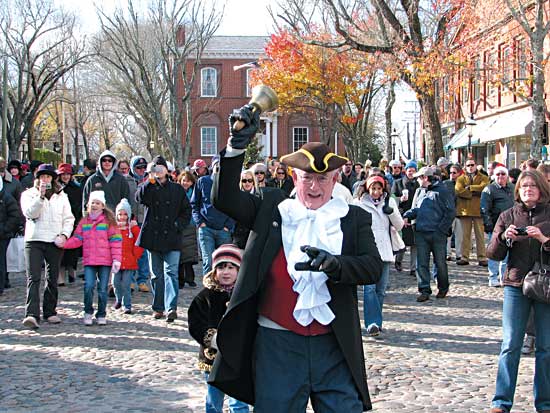The History of Nantucket’s Town Criers
by Helen Didriksen

Town Crier Billy Clark
Photo courtesy of the NHA |
Nantucket Town Crier Curtis Barnes has served for almost thirty years, but that is a drop in the bucket in terms of Town Crier history.
The first town criers worked in ancient Greece—heralds used to announce the severings of relationships that would lead to war, or the proposals of armistices that would lead to peace. Their “stentorian” (extremely loud) voices were often remarked upon, and were named after the Trojan warrior Stentor, whose voice was said to be as powerful as the voices of fifty others.
In Norman England, criers were the spokesmen for the king; their “oyez, oyez, oyez” (Old French for “hear ye”) was used to draw the attention of the mostly illiterate populace to important matters of state. They were under the king’s protection; hence the command “Don’t shoot the messenger” had real meaning.
By the sixteenth century, local news was also being spread in this way. It was not unusual to have husband-and-wife teams operating, the wife ringing the large hand bell and the husband doing the shouting. They must have been people of some education, as they had to be able to write and read the proclamations—afterwards, typically, posting them on the door of the (ubiquitous) tavern. (This is how newspapers came to be named “posts.”)
In Scotland, women operated on their own. Some of the known ones had names like Beetty Dick (1693–1773), Peggy Haswell, and Jessie Garvald (nicknamed “Garvald Gundy” after the sweetmeat known as gundy that she sold to children). Peggy and Jessie used bells, but Beetty hit a spoon against a wooden trencher.
Town criers on Nantucket must have operated earlier, but the ones we know of date back to the nineteenth century. The best known is William (“Billy”—but he objected to being called that) Clark (1846–1909), whose horn still resides in the lower-level sanctuary of the Unitarian Church. But Joseph Farnham, a boyhood contemporary (who calls Clark “of humble birth” and “eccentric and of limited education”) recalls others in his memoirs: Charles Murphey, Timothy W. Riddell (both also auctioneers), and Charles H. Chase. The 1885 obituary of Captain George Haggerty, besides mentioning his “three seasons in the Arctic” and the fact that he was a Liberty Street shoemaker, took note that “he has had charge of ringing the town bell for several years.” Arthur Gardner, in a 1913 issue of the Inquirer and Mirror, remembers a Joseph Coffin in his boyhood, who rode a tipcart, rang a hand bell, cried “whoa,” and then made public proclamations. A tourist guide of 1902 mentions “an early” Quaker crier named Jinks, and a contemporary crier named Hull, “who also supervises the rope which rings from out the tower [after the clock has struck] the hours of 7, 12, and 9 (curfew).” ("Not always at the proper hour," according to Clay Lancaster.) At the Unitarian Church, the ring, if not the rope, continues today, as it was legislated in 1849. There are fifty-two rings each time, or three minutes’ worth. “Hull” would have been Alvin Hull, son of George R. and Lydia, born in 1845 and also a town auctioneer.
Billy Clark’s crying was irretrievably linked to newspapers and the daily arrival of the boat. He had sold newspapers for the Mirror as a boy (and occasionally set type, though apparently poorly). Now it was the mainland newspapers that were his concern, the town's only source of hard news in those days (the local papers being filled mostly with stories and poetry).
He began by “sighting the boat” from the Old South (Unitarian Church) Tower, blowing his horn in all four directions from the windows above the belfry. According to his obituary, “if it was a foggy day the notification meant that the boat would be in in thirty minutes, and there was a rush for the wharf. If it was a clear day . . . the boat was still two hours off.” (Other accounts say one hour.)
The “rush” is an event hard to imagine today. The 1902 tourist guide describes it this way: “The wharf is literally black with towns-people and visiting tourists who are present either to welcome some dear friend, else to participate in the inevitable rush. . . . The efforts of three policemen to succumb the hilarity of this troop is a veritable burlesque. Twenty or thirty carriages are lined up. . . . Kerchiefs float cheerily welcomes and coquettish flirtations to someone aboard. . . . As the boat slowly pulls towards the wharf there is a great abandon of formality and a bedlam of noise reigns supreme. Above the melee of a sudden rises another – that of “Billy” Clark, the traditional, impressible and famous vocalist whose fish-horn voice fairly outshines the collective racket of the crowds – his one wild cry of “News! News! Hor-ri-ble News! Fire in New York.”
Or it might be, “’Nother severe murder in New York! Man killed his wife, then killed himself – both of ’em dead.” Or, “Now there’s been a FEARFUL FLOOD out west – Mississippi River’s under water.” Not the least of Billy’s appeal was his eccentricity. But he was a sound businessman. He then sold the newspapers. Often, they were sold out before the last passenger was off the boat.
He also took on local announcements (and, unlike his boat announcements, for these he was often paid). Some examples: “Meat Auction! Going to be a meat auction this morning, at 10 o’clock, corn beef, fresh beef and pork. Geo. E. Morris! Geo. E. Morris! Don’t forget!” Or: “Concert in Athenaeum tonight! Go and see it! Commences at 8 o’clock! Go and see it.” (We have a receipt for one of his Athenaeum announcements.) Or: “Dance tomorrow night at skating rink, tickets 50 cents, considerable going on.” Farnham also remembers announcements specifically aimed at tourists: “Great surf at the south shore”; “Very heavy, high-rolling surf and breakers at Surfside.” For these street announcements, says Farnham, Clark would first ring a “large, clear brass bell.” Ellen Miner Round, writing in June of 1881, also remembers a bell for auction sales and a horn for “every item of news.” But others remembered bell and horn used together and even simultaneously. Sometimes, the two types of announcement were even merged. H. S. Wyer published a "Midsummer Calendar" in 1898 in which he has Billy saying: "BIG MURDER in Chicago. Awful news in the paper today. Does any lady or gent want to buy watermelons? Vessel at Straight Wharf."
The architectural historian Clay Lancaster wrote a seven-page essay on Billy, in which he reminds us that his birth on November 17 was the other “momentous” event of 1846. (The first, of course was the Great Fire of July 13.) He says Billy performed sightings other than “the boat” (he has it coming from Woods Hole) from the tower – among them, mariners in distress. He was once chastised by neighbors for blowing his horn too early – at 6:30 A.M. in the summer of 1880, for the boat bringing in railroad ties to begin construction of the excursion line to Surfside and ’Sconset. But this paid off: he was given the honor of driving in the first spike. Later, after a short section of track had been laid, he was on board the flatcar that gave members of the press their first ride. And finally, in 1884, when ’Sconset was at last reached, he was part of the “Glorious Eighth” celebration (the original, Fourth of July event had had to be postponed four days because of rain). As the train arrived at noon, Billy stood nearby with a gilded sledge hammer and golden spike. And as the Mechanics Band debarked and struck up "Yankee Doodle," he drove that spike home.
In general, Billy had little respect for his few competitors. He said they spent most of their time up in the Unitarian church tower watching for fires. If one was spotted, they alerted him, he said, and he was the one to “make a big noise” with horn and bell to assemble the volunteers. Boyhood acquaintance Joseph Farnham, however, describes Chase and Murphey as “traveling the streets . . . heralding local notices, the coming of the circus, and other public events.” Charles Murphey, however, was not a competitor. Rather, he directly predated Billy, operating “at one time, and perhaps all the time of my boy life,” according to Farnham.
There is only one report of a direct competition, and that was with Alvin Hull. Hull had a reputation for speed; he had served as mounted orderly of a Colonel Jeffries of the Seventh Ohio Regiment during the Civil War.
In 1889, Captain Anthony Smalley was up for reelection to the state legislature, and Hull was on hand for the vote counting. As the tally neared its end, and victory for Smalley seemed assured, Hull decided to deliver the good news. He set off at top speed, but then hesitated: maybe he should turn back, and wait for a full count. As he did so, who should steam by but Clark, his purpose only too apparent to Hull. After a quick check on the results, Hull was also on his way, even tying Clark until the latter turned onto a side street. As Hull reached the captain's front door, Clark reached his back window, blew his horn, and extended his hand in congratulations. According to Lancaster, "A week later, Alvin Hull was circulating a petition seeking appointment as keeper of the Brant Point Lighthouse."
Clark and Hull are also the only two recorded to have been extended honors off-island. The Boston Globe reported on Hull's visit to Boston on March l, 1894 (after an appearance before the board of pension examiners in Taunton) as his first since the Civil War. What most impressed him were the “electric cars,” and he was “bound that Nantucket shall have them.” The paper went on to say that he was “known as ‘Doc,’” appeared in minstrel shows and wrote rhymes, and had not once missed ringing the curfew bell in ten years. His son was doing it in his absence, but he would “return to Nantucket tomorrow and take up the round of duty again.”
Similarly, when Clark had traveled to New Bedford in the summer of 1879, both its Mercury and Standard newspapers took note. He was “the popular town crier and bill poster of Nantucket” who would “undoubtedly give the islands a glowing account” of New Bedford. He couldn't stay long, because “the people of the tight little island could not survive long without hearing Clark's horn.” Three years later, the Observer and Register of Salem performed a similar service. Clark had spent a week with “a prominent citizen,” and, according to his report to the Inquirer and Mirror, had a “nobby-nobby time.”
In the end, Billy’s profession left him both voiceless and impoverished. It was said his voice now sounded like his horn, and strangers to the island complained they could not understand him. (Understandably, he resented it if asked to repeat himself.) On May 21, 1903, he struggled home from the wharf with an illness that incapacitated him. Though well enough in the summer of 1904 to sell postcards of himself as “the old Town Crier,” he never again resumed his duties. From then until his death on August 17, 1909, he was in part supported by the town he had devoted his life to. Summer residents sponsored an extremely successful benefit concert at the Athletic Club in September 1905 (with mezzo-soprano Marguerita Hall performing). The Inquirer and Mirror started a Billy Clark Fund in 1908. He spent his last days in the care of his sister.

Town Crier Howard Barber and his wife in pilgrim costume.
Photo courtesy of the NHA |
In the twentieth century, the wireless, telephone, radio, and airplane made the town crier obsolete – at least as far as the conveying of news was concerned. But he was still useful during ceremonial occasions. Paula Williams, Bob Mooney, Nancy Chase, and Ruth and Bill Grieder all remember Howard Barber performing such duties in the 1950s. During Nantucket's 300th Anniversary celebration in July 1959, Paula remembers him walking through town ringing a bell. And we have three pictures of him in costume from about this time. In one, he and his wife stand on a south shore beach dune in Pilgrim costumes. He is a Pilgrim again on South Water Street, ringing a bell and advertising a village band concert. And in the third, he wears a large top hat and a button announcing an orchestral event.
From Providence and Brown University, he was in town for at least ten years (Jean Egan remembers singing in the choir with him at the Congregational Church for that long). His style was subdued: Ruth Grieder describes him as "very sedate – not loud and boisterous at all – a very quiet gentleman." But his appearance was not. Everyone recalled the extraordinary length of his neck – a “turtle neck,” Bob Mooney called it. Says Ruth, with a top hat, he had to have been over seven feet tall.
Tibby Allen remembers that her father, Jules Thebaud, performed town crier-like functions on more than one occasion—wearing a tall hat, ringing a bell, and calling "Hear ye, hear ye.” But she has no idea why. Born in 1902, he was a third-generation Nantucket summer resident, and beloved Nantucket Yacht Club commodore (known as “Uncle Jules”). He was also active at Saint Mary's Church and on the Nantucket Cottage Hospital board. His activities may have been connected to any one of those organizations. This was probably in the late ’40s or early ’50s (Ginger Heard, another commodore's wife, thinks she would remember if it had been after she married Hamilton Heard in 1953).
But since 1980, the one and only Nantucket town crier has been Curtis Barnes. Curtis had just moved to Nantucket from Philadelphia, and was commuting to his job as a senior administrator (emphasis, appropriately, on public relations) at Tufts University. Two Chamber of Commerce members were taking turns being town crier then, and not too enthusiastically. He was asked to take over. “Being the ham that I am, I said yes,” he told the Inquirer and Mirror in 2001.

Current Town Crier, Curtis Barnes on duty at Christmas Stroll.
The Tufts theater department offered to suit him up. His outfit then included a velvet cape and buckled shoes (they wore out). He has learned to opt for more comfort – particularly for his Fourth of July stint, when he announces the fire hose fight (he knows he is going to get wet). Then, he retains his red vest and ruff, but adds only a white, button –down shirt and khaki pants. He is on his third tricornered hat. His other regular “jobs” are the lighting of the trees on Thanksgiving weekend, bringing in Santa (from a Coast Guard cutter) Stroll Weekend the following week, and the Christmas Eve drawing. The last is his favorite, because it is strictly local. The winner must be there to win, and a single, $25 purchase from a local merchant (which earns one red ticket) could bring in $5,000. What Curtis loves best is the enthusiasm of the crowd when that lucky one (who will be known by many) is announced. In general, the best part of his job is that “everyone's happy.”
In the beginning, he used a borrowed bell. But when he retired from Tufts in 1985, his parting gift from President Jean Mayer was “Fiddian.” That is what is engraved above the curve of the bell that Curtis has used ever since. It is a World War II air raid–warning bell; ARP, for Air Raid Patrol, is engraved on the bell itself. Fiddian is an early Cornwall surname. It derives from the Latin Vivianus (which became Vivian), and means “alive” or “living.” Curtis plans to donate Fiddian to the Chamber should he retire (more on that), that it may become the town crier's bell in perpetuity.
His background suited the job. He began as a photojournalist for the Rochester Times Union (1952–62), and “as a journalist one is always acting.” (It was in that capacity, by the way, that he met his wife, Joan, then a student at Syracuse University. They have been married for fifty-three years and have four sons—one of whom, following in his father's footsteps, is a senior correspondent for the Fox News channel. He has seven grandchildren.) As his family grew, he turned to a more lucrative career in higher education. He was at the University of Rochester, Clarkson, Elmira, Syracuse, and the University of Pennsylvania before Tufts, serving, among other things, as Marshall at graduation events (the one who organizes who marches where). He has also had to deal with student sit-ins. So his crowd control skills were well honed when he came to Nantucket.
On the island, his major full-time volunteer activity is also people oriented. He is Coordinator of Lay Ministry at Saint Paul's Episcopal Church, where he is particularly proud of his work training young chalice bearers. The young are his favorites as Town Crier too. His favorite picture (of the hundreds taken with tourists each Stroll Weekend), by the Cape Cod Times in 2006, is Pied Piper like – of him with children at the lower monument.
How long will he continue as Town Crier? He has a fairly positive answer: "As long as my feet hold out."